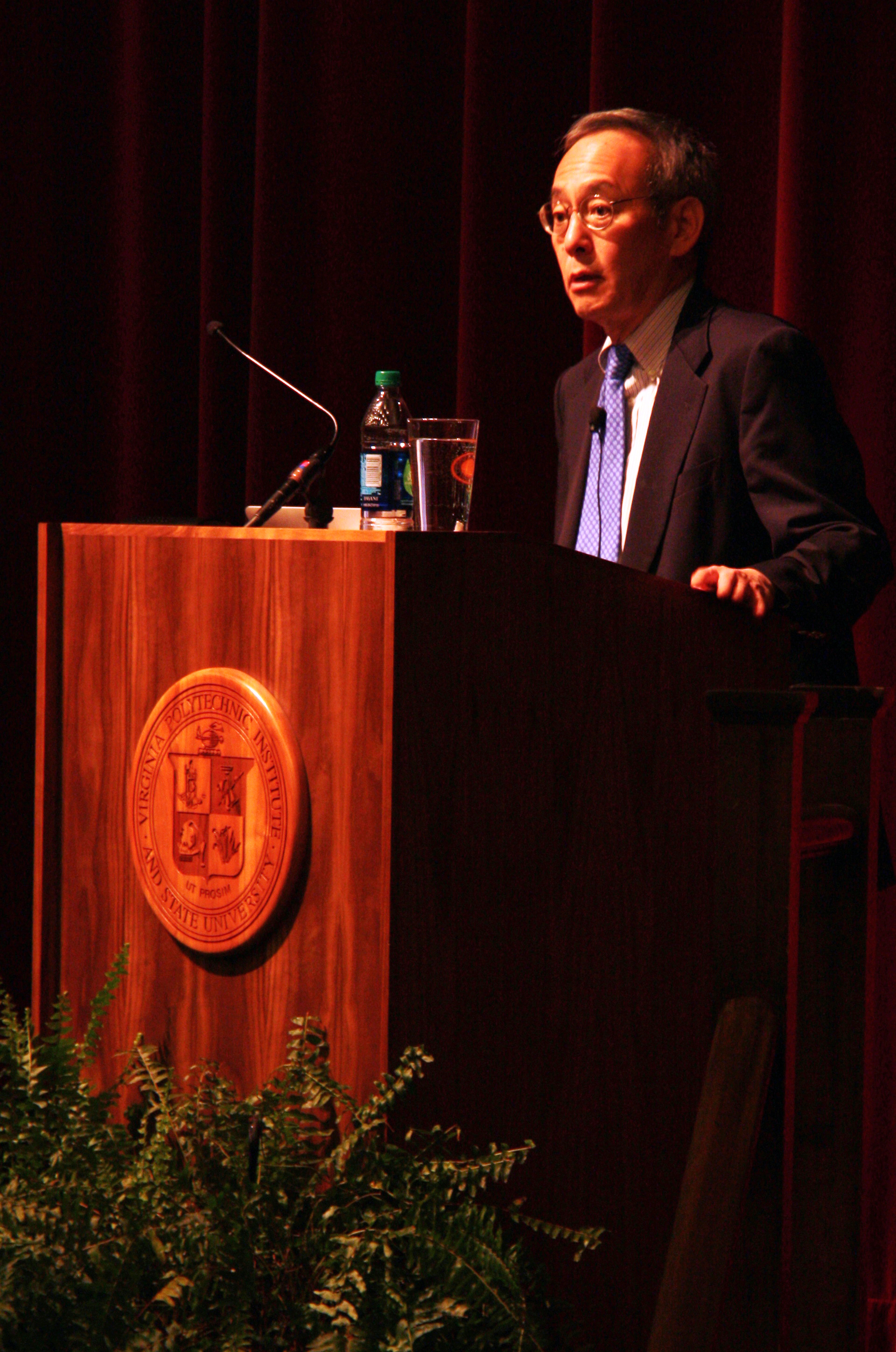Nobel laureate talks about innovation in modern research world before capacity Burruss audience

Steven Chu, a Nobel laureate and a former United States Secretary of Energy, talked about how to create a research and development environment modeled after the famously successful “Bell Labs” on Friday during the initial Hugh and Ethel Kelly Speaker Series presentation, hosted by the Institute for Critical Technology and Applied Science (ICTAS) and the College of Engineering.
Chu said researchers in today's research climate are forced to concentrate on their best ideas, work in small groups, and to collaborate with experts from different fields. In that respect, it reinforces the Bell Laboratories' philosophy to build small research groups containing usually just an investigator, a postdoctoral associate, and a lab technician, and to have active scientists fill the management roles.
"A small group makes you think hard about the most important things to work on, and being forced to share ideas may be a good thing," Chu said. "That's the lemonade from the lemons."
Bell Laboratories was a hub of innovation throughout the 20th century, creating breakthrough discoveries such as the transistor, communication satellites, touch-tone phones, digital signal processing, and data networking. Chu’s work to capture atoms with laser light while at Bell Labs earned a Nobel Prize in physics.
"When people have a great idea, the first thing we want them to do is not to write it down, not to file a patent, but to go tell a colleague and start brainstorming," Chu told a capacity crowd in the Burruss Hall auditorium.
He said Bell Labs produced research breakthroughs because corporate leaders held consistent values. Each succeeding CEO or board of directors believed in the benefits of research and resisted the pressure of Wall Street. In the labs, the top managers were also the top practicing scientists, leading by example.
"Great people establish a culture of high expectations," Chu said.
A co-recipient of the 1997 Nobel Prize for Physics for his contributions to the laser cooling and trapping of atoms, Chu tests fundamental theories in physics, atom interferometry, the study of polymers and biological systems at the single molecule level, and biomedical research. He is the author of 250 scientific and technical papers and holds 10 patents.
The lecture was held in conjunction with ICTAS Research Day activities.
Roop Mahajan, director of ICTAS, revealed his vision for the future of the institute in 2020, which currently has an $8.3 million annual budget, 350 supported faculty members, 40 doctoral scholars, and 20 research centers.
“We are committed to acting today to make Virginia Tech and ICTAS a powerhouse in a few select areas by 2020,” said Mahajan, who also serves as the Lewis A. Hester Chair in Engineering in the Department of Mechanical Engineering. “It is a matter of finding those areas consistent with ICTAS mission where we already have significant strength, where there are faculty members interested in leading a broad effort, and where there is significant opportunity for growth in the coming years.”
By 2020, the institute intends to be internationally known for interdisciplinary research with a presence in Asia, Europe, Latin America, Africa, and Australia. The institute hopes to partner with all colleges at Virginia Tech, to include the Pamplin College of Business, and College of Liberal Arts and Human Sciences, as well as the other Tech institutes. The ICTAS 2020 plan also hopes to expand their facilities locally and internationally.
ICTAS Research Day also included poster presentations by doctoral students working in biology, engineering, veterinary medicine, and other diverse fields.
Among them, Konstantinos Krommydas, a fourth-year doctoral associate from Greece in the Systems, Networking, and Renaissance Grokking Lab (SyNeRGy) of the Department of Computer Science in the College of Engineering, talked about heterogeneous computing, which refers to computing systems that use more than one type of processor to execute programs or applications, which can be found in everything from mobile devices to the fastest supercomputers.
Heterogeneous computing includes the traditional central processing unit and the graphics processing unit working together like two sides of a brain. However, such computing systems do not yet know how to automatically and optimally switch between the two types of brains. Krommydas’ research aims to identify and improve the “universal computation and communication patterns” within heterogeneous computing systems.




